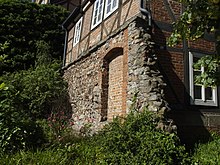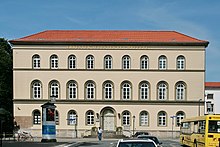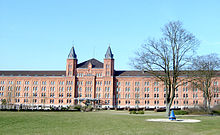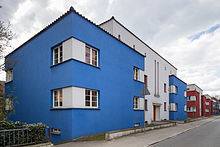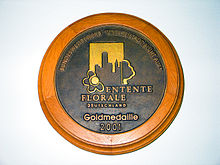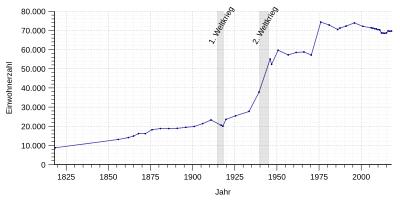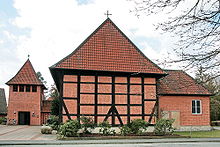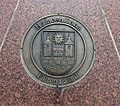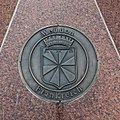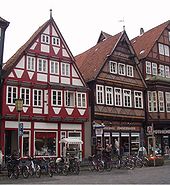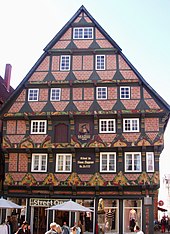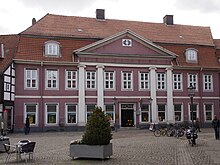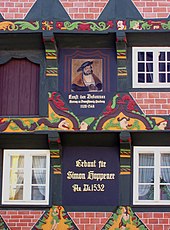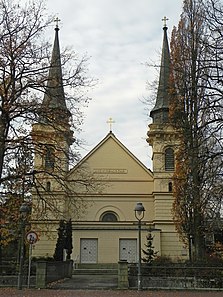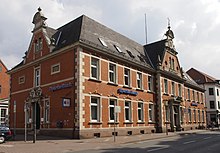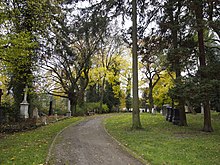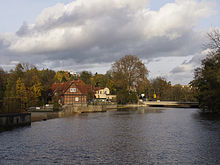Celle
| coat of arms | Germany map | |
|---|---|---|

|
Coordinates: 52 ° 38 ' N , 10 ° 5' E |
|
| Basic data | ||
| State : | Lower Saxony | |
| County : | Celle | |
| Height : | 40 m above sea level NHN | |
| Area : | 175.04 km 2 | |
| Residents: | 69,540 (Dec. 31, 2019) | |
| Population density : | 397 inhabitants per km 2 | |
| Postcodes : | 29221-29229 | |
| Primaries : | 05141, 05086 | |
| License plate : | CE | |
| Community key : | 03 3 51 006 | |
| LOCODE : | DE CEL | |
| City structure: | 17 districts | |
City administration address : |
Am French Garden 1 29221 Celle |
|
| Website : | ||
| Lord Mayor : | Jörg Nigge ( CDU ) | |
| Location of the city of Celle in the district of Celle | ||
Celle [ ˈtsɛlə ] is a large independent city with around 70,000 inhabitants and the district town of the district of Celle in Lower Saxony .
Celle is considered the southern gateway to the Lüneburg Heath and is a place with a picturesque old town with over 400 half-timbered houses and a palace in the Renaissance and Baroque styles.
geography
Celle lies in the glacial valley of the Aller , a tributary of the Weser . It is around 40 km to the Lower Saxony state capital Hanover in the southwest, Braunschweig is 65 km to the southeast and Hamburg in the north is 120 km. After Lüneburg, Celle is the second largest city between Hanover and Hamburg.
The area of the city is 176.05 km². Within the urban area, the Lachte River in the east and the Fuhse River in the west flow into the Aller.
|
Bremen (110 km) Walsrode (50 km) |
Flensburg (280 km) Hamburg (120 km) |
Lüneburg (95 km) Uelzen (60 km) |
|
Nienburg / Weser (65 km) |

|
Wolfsburg (65 km) Berlin (270 km) |
| Hanover (40 km) | Hildesheim (60 km) |
Braunschweig (65 km) |
* Distances are rounded road kilometers to the town center.
- Celles sights
Castle , view from the city church tower
Old town hall and town church in winter
Steel engraving from the market square around 1845
City structure
The city is divided into the following districts (figures from December 31, 2016):
| district | Residents | Area in km² |
Inhabitants per km² |
|---|---|---|---|
| Altencelle | 4,804 | 24,280 | 198 |
| Altenhagen | 856 | 7.102 | 121 |
| Blumlage / old town | 8,374 | 4.011 | 2,088 |
| Bostel | 602 | 5.359 | 112 |
| Boye | 841 | 8,449 | 100 |
| Garßen | 2,725 | 32.891 | 83 |
| Groß Hehlen | 2,846 | 14,950 | 190 |
| Hehlentor | 7,746 | 3.530 | 2,194 |
| Hustedt | 558 | 14,198 | 39 |
| Klein Hehlen | 5,795 | 4,997 | 1,160 |
| Lachtehausen | 642 | 7.461 | 86 |
| Neuenhäusen | 7,951 | 2.970 | 2,677 |
| Neustadt / Heese | 10,728 | 10.216 | 1,050 |
| Shy | 1,047 | 13.093 | 80 |
| Vorwerk | 3,185 | 3.894 | 818 |
| Westercelle | 6,936 | 7.967 | 871 |
| Wietzenbruch | 4,837 | 10.671 | 453 |
| total | 70,473 | 176.045 | 400 |
Neighboring communities
The following communities border the city of Celle. They are named clockwise starting in the north and all belong to the district of Celle : City of Bergen , Eschede , Beedenbostel and Lachendorf (both integrated municipality Lachendorf ), Wienhausen (integrated municipality Flotwedel ), Nienhagen and Adelheidsdorf (both integrated municipality Wathlingen ), Hambühren and Winsen (Aller) .
climate
The annual precipitation is 692 mm. It is in the middle third of the values recorded in Germany. Lower values are registered at 39% of the measuring stations of the German Weather Service . The driest month is February, the most precipitation falls in August, 1.5 times more than in February. They are almost evenly distributed over the year. Lower seasonal fluctuations are recorded at only 1% of the measuring stations .
The annual mean temperature is 8.9 ° C. The warmest months are July with an average of 17.5 ° C and August with 17.1 ° C and the coldest January with 0.6 ° C and February with 1.1 ° C.
history
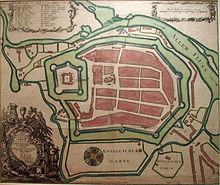

middle Ages
Celle was first mentioned in a document in 985 as Kellu ("settlement on the river"). In the 11th century the city had the right to mint coins . Some coins can be found in the coin find of Sandur in the Faroe Islands . In 1292, Duke Otto II der Strenge gave up Altencelle , where a fortification in the form of the Burg wall was already in the 10th century . He founded a rectangular settlement 4 km northwest of the already existing castle . In 1301 town charter was granted. At the same time the construction of the town church began.
In 1378, Celle and Duke Albrecht became the residence of the Dukes of Saxony-Wittenberg . During this time, the construction of the city fortifications of Celle with a city wall is assumed. From 1433 the princes of Lüneburg resided in Celle Castle. 1453, Duke Friedrich the Pious , just outside the city Franciscans - cloister . On October 3, 1453, Pope Nicholas V approved the transfer of the convent to the city. In 1464, the grain shipping monopoly enabled the city to flourish.
Modern times
In 1524 the Reformation was introduced in Celle by Duke Ernst I (the Confessor) of Braunschweig-Lüneburg . Celle was the first city after Wittenberg to fully join the Reformation.
In 1570 his son Duke Wilhelm built the castle chapel, which was inaugurated in 1585.
In 1660, Duke Christian Ludwig von Celle erected a heron stake with an inscription in Altenhagen , reminiscent of the heron stain with falcons. From 1665 to 1705, Celle experienced a cultural heyday as a residence under Duke Georg Wilhelm with an expansion and conversion of the medieval castle into a four-wing baroque castle. Culturally influential was Georg Wilhelm's French wife, Eleonore d'Olbreuse , who brought Huguenot co-religionists and Italian builders to Celle. During this time the French and Italian gardens were laid out and the baroque palace theater was built. The Huguenots received their own church in 1700 , today one of the few surviving Huguenot churches in northwest Germany.
The last Duke of Celle died in 1705 and bequeathed the Principality of Lüneburg to the Hanoverian Guelphs . Celle now belonged to the Electorate of Braunschweig-Lüneburg . As a substitute for the loss of its status as a residential town , Celle received three administrative institutions in the following decades: the higher appeal court, the penitentiary and the state stud . This began the development of the city of civil servants and lawyers. Even today u. a. the State Social Court of Lower Saxony-Bremen and the Higher Regional Court responsible for most of Lower Saxony are located in Celle. At the same time, there is a correctional facility ( JVA Celle for short ) in Celle , the Salinenmoor branch of which was closed 11 km north of the city center in 2014. The fact that the citizens of Celle once - given the choice - preferred to bring the penitentiary to Celle than an offered university in order to protect the innocence of their daughters cannot be proven, but persists as a popular anecdote.
In 1786 Albrecht Thaer founded the first German agricultural research institute in the Dammaschwiesen (today Thaers Garten). The Albrecht-Thaer School is now part of a vocational training center in the Altenhagen district of Celle .
Modern
In 1842, which was Cambridge Dragoons Barracks for the same name by Prince Adolphus, 1st Duke of Cambridge named first Hannoversche Dragoons. 9 built. After expansion in 1913 and reconstruction after partial fire damage in 1936, the barracks were renamed Goodwood Baracks in 1945 and from 1976 to 1996 was the seat of the Bundeswehr's 33rd Panzer Brigade ; the renewed renaming to Cambridge-Dragoon barracks took place in 1980. Since 1996 the site has been the seat of one of the largest youth centers in Lower Saxony ( CD barracks ).
From 1869 to 1872 the large infantry barracks were built for the 77th Infantry Regiment. In 1938 the barracks were renamed Heidekaserne . After the Second World War , the barracks were used by British troops who left the site in 1993. The new town hall with the Celle city administration has been located in the converted monumental brick building since 1999 , residential buildings and the city park have been created on the surrounding open spaces and the parade ground.
In 1892 - with numerous donations from citizens - today's Bomann Museum was founded with important folklore and urban history collections. In 1913 the 74 m high bell tower of the town church was built, the bell work of which was extensively renewed in 2008. During the First World War there were two prisoner-of-war camps in and near Celle: On the one hand, the "Cell camp" was built in Scheuen , which was initially a team camp and then an officer camp with up to 10,000 British, Serbs, Russians, Belgians, French and Italians. In Celle Castle a prison camp was set up, were interned in which up to 300 "civilian prisoners higher position in life." These were mainly students, merchants, industrialists and artists of hostile nationality who lived in Germany or were in transit at the beginning of the war, as well as public figures taken hostage in the occupied territories of France and Belgium. The first military cemeteries were created.
In 1928, the "Spinnhütte - silk spinning and weaving GmbH" was founded in the district Hehlentor, four years later, with the Peiner silk mill united to "silk factory Spinnhütte AG". By the end of the 1930s, the company developed - alongside the military facilities - into the largest company in Celle with 670 employees. The shareholders of the stock corporation were expropriated in the summer of 1936 after a conversion of outstanding loans from the “Bank of German Aviation”, which belonged to the sphere of influence of the Reich Aviation Ministry , as well as a balance sheet manipulation, and the assets of the AG were transferred to “Mitteldeutsche Spinnhütte GmbH”. The background to this action was that the numbers and data of the GmbH did not have to be published and thus the production numbers could also be kept secret. The main product of the Spinnhütte was parachute silk, which was required for the equipment of the paratrooper troops, which had been set up since 1936, in addition to which a small number of civilian products were also manufactured. In 1937 the Spinnhütte was awarded the title “ National Socialist Model Company ” and in 1943 the title “War Model Company ”. As part of the expansion of Mitteldeutsche Spinnhütte GmbH, branch plants were built in Peine, Plauen , Wanfried , Apolda , Osterode and Pirna . There were also factories in Telgte and, during the war, in Serbia. The state social court of Lower Saxony is now located in the main administration of Mitteldeutsche Spinnhütte GmbH, which was completed in 1940 . Towards the end of the war, experiments on uranium enrichment with the help of the ultracentrifuge took place in an outbuilding of the Spinnhütte as part of the "Uranium Association". This work was under the direction of the Hamburg physical chemist Paul Harteck .
The Reichsanstalt für Seidenbau was built on Dörnbergstrasse 1938–1941 near the Celle spinning mill, and was continued as a federal research facility after the Second World War (since 2002 the Institute for Animal Welfare and Husbandry ).
In September 1929, Rudolph Karstadt opened a monumental Karstadt department store on Poststraße in the middle of the half-timbered old town, which was newly built from 1927 and which was similar in its facade design to the Karstadt department store on Hermannplatz in Berlin . The Karstadt store in Celle was demolished in 1965 and replaced by an even larger, controversial department store based on a design by Walter Brune . The folded facades with a grid structure, which emerged from an architectural competition chaired by Rudolf Hillebrecht , represented, in the opinion of the jury, a successful formal takeover of the Celle framework.
The Celle architect Otto Haesler built around a dozen individual buildings and settlements in the New Building style from 1924 to 1932 , which received strong national and international attention during the Weimar Republic . These include the Italian Garden (1925), Georgsgarten (1927) and Blumläger Feld (1930–31) settlements as well as the Old Town School (1928), the Waack residential group (1928), the Rector's residence (1928) and the director's residence (1930).
time of the nationalsocialism
The memorial book of the Federal Archives for the Victims of the National Socialist Persecution of Jews in Germany (1933–1945) lists 39 Jewish residents of Celle who were deported and mostly murdered . The central database of names of Holocaust victims (Beta) by Yad Vashem listed by name 31 Jewish citizens Celles of which were killed at least 27th
The time of National Socialism in Celle is presented in detail in a historical tour "Celle under National Socialism".
The stops on this tour include:
- the memorial in the Triftanlage ,
- the " Otto Telschow House ",
- the district office,
- the von der Wall family's residential and commercial building,
- the judicial prison as a passage to the concentration or education camp ,
- the Julius Wexseler textile shop,
- the "Brown House",
- the Freidberg department store,
- the town hall,
- the higher regional court ,
- the Hereditary Health Supreme Court ,
- the regional court court ,
- the woman's house,
- Robert Meyer - Hamburg wholesale warehouse,
- Hasall men's fashion store,
- Salomon shoe store,
- Manufactor and fashion goods Wolff,
- Victor Roberg manufactory and fashion goods,
- Löwenstein shoe store,
- Manufactory store Hellmann,
- German Labor Front Office ,
- " Strength through Joy " store,
- Family Kohls - "baptism of Jews",
- the local police authority,
- Jews in the Blumlage,
- Feingersch family,
- synagogue
During the Reichspogromnacht from November 9th to 10th, 1938, the synagogue was not completely destroyed because there would have been a risk for an adjacent leather factory and other parts of the historic old town.
On April 8, 1945 there was the only Allied air raid on Celle during the Second World War , in which the station facilities were the target. Several waiting trains, in which there were also around 4,000 concentration camp prisoners, were badly hit and hundreds of people were killed. Some of the concentration camp inmates from the trains managed to escape to nearby Neustädter Holz , but SS guards and citizens of Celle shot a large number of the refugees in the following two days. The number of victims is assumed to be at least 170 people. Cynically called "Celler Hasenjagd" by the perpetrators , the massacre represents the darkest chapter in the history of Celle.
A major destruction of the city was prevented by the fact that the city was handed over to the Allied troops on April 12, 1945 without resistance.
military

The long tradition of Celle as a location for military facilities began in the middle of the 19th century with the construction of the Cambridge Dragoons barracks on the southern arterial road to Hanover (Hannoversche Heerstraße) and the large infantry barracks in Wildgarten for the 77th infantry regiment near the old town .
During the National Socialist era , parts of Infantry Regiments 17 and 73 and Artillery Regiment 19 had their garrison in Celle. Celle was the seat of a military district command and a military registration office. In 1934 the Celle military airfield opened in what is now the Wietzenbruch district. In addition, Celle was the location of the Seeckt barracks , built between 1936 and 1939, with the Heeresgasschutzschule and the army's smoke thrower and detoxification force located next door, located in the northern outskirts of the city .
Celle retained its status as a garrison town even after the Second World War . British troops moved into some barracks . Other barracks (including the Freiherr von Fritsch barracks in Scheuen and the Cambridge Dragoons barracks in the city center) later served as locations for the Bundeswehr's 33 "Celle" tank brigade . The Army Airfield Celle (Immelmann barracks) in the Wietzenbruch district is now the location of the TE900 Celle of the International Helicopter Training Center in Bückeburg. From the 1990s onwards, several barracks were converted into civilian uses. The former large infantry barracks (Heidekaserne) houses the New Town Hall, the former Cambridge Dragoons barracks and the like. a. the youth and culture center CD-Kaserne and the Halle19 stage of the Celle castle theater. Overall, Celle has lost a large part of its function as a garrison town since the end of the Cold War . The remaining military facilities, however, still represent a not insignificant economic factor for Celle.
After 67 years of British military presence in Celle, the last British unit with around 600 soldiers, the second battalion of the Royal Regiment of Fusiliers , withdrew in August 2012 . It was housed in the former von Seeckt barracks on the Hohe Wende (later Trenchard Barracks) . The unit was relocated to the Akrotiri and Dekelia military bases in Cyprus .
The Garrison Museum Celle, which is located on the Allerinsel in the last building of the demolished former slaughterhouse, provides information on the history of the garrison location.
post war period
After the Second World War, Celle applied for the seat of the Parliamentary Council alongside Bonn and Frankfurt am Main and a few other cities . In the end, however, the choice fell on Bonn.
In preparation for the start of color television based on the PAL system in the Federal Republic of Germany in August 1967, Telefunken built a new factory for the production of color television receivers in the Klein Hehlen district of Celle from 1964 , which began operations in May 1966. In the 1970s, the city's largest employer at the time employed up to 2,800 people. The Telefunken television equipment factory belonged to the French Thomson-Brandt group from 1984 and was closed in 1997. A shopping center with a hardware store is located on the former factory premises on Telefunkenstrasse.
On January 1, 1973, the city lost its status as an independent city and became the largest municipality in the district of Celle . At that time it was also the largest city in the newly created government district of Lüneburg . The villages of Ummern, Pollhöfen and Hahnenhorn were incorporated into the Gifhorn district. Since then, the parish of Hohne has looked after six villages ( Hohne , Helmerkamp, Spechtshorn , Ummern, Pollhöfen and Hahnenhorn) in two districts. At the same time, a number of villages in the vicinity were incorporated into the city of Celle.
On July 25, 1978, the Lower Saxony constitution protection agency carried out a fake bomb attack on the outer wall of the prison . This event became known as Celler Loch .
In 2001 the city of Celle was honored with the gold medal at the first national competition, Our city is blossoming .
In 2004, the administrative district of Lüneburg was dissolved again along with all of the other administrative districts in Lower Saxony. Celle is currently the twelfth largest city in Lower Saxony .
In 2017, Celle was awarded the honorary title of “ Reformation City of Europe ” by the Community of Evangelical Churches in Europe .
Incorporations
- 1869: Altenhäusen, Blumlage, Heese , Hehlentor , Neuenhäusen , Neustadt and Wietzenbruch (partially)
- 1939: Klein Hehlen
- 1961: Vorwerk (Celle)
- 1968: Boye
- 1973 (January 1st): Altencelle , Altenhagen , Bostel , Garßen , Groß Hehlen , Hustedt , Lachtehausen , Scheuen and large parts of Westercelle
Population development
Celle only had a few thousand inhabitants in the Middle Ages and early modern times . The population grew only slowly and fell again and again due to the numerous wars, epidemics and famine. Only with the beginning of industrialization in the 19th century did population growth accelerate. In 1818 only 8,800 people lived in the city, by 1900 there were already 20,000. Due to incorporations on April 1, 1939, there was a further increase to 38,000 inhabitants.
Shortly after the Second World War , the large number of refugees and displaced persons from eastern Germany led to an increase in the population of 17,000 people to 55,000 in December 1945 within a few months. Incorporation on January 1, 1973 brought an increase from 18,691 to 75,178 inhabitants, the historic high .
The census on May 25, 1987 showed 71,222 inhabitants. On June 30, 1995, the official population was 73,961 according to an update by the Lower Saxony State Office for Statistics, on December 31, 2013 it was 68,508 and four years later 69,706 (only main residences in each case and after comparison with the other state offices).
The following overview shows the number of inhabitants according to the respective territorial status. For 1818 it is an estimate, then census results (¹) or official updates from the State Statistical Office. From 1871, the information relates to the local population, from 1925 to the resident population and since 1987 to the population at the location of the main residence. Before 1871, the number of inhabitants was determined according to inconsistent survey procedures.
|
|
|
|
¹ census result
religion
Celle is the seat of the parish of the same name in the Lüneburg district of the Evangelical Lutheran Church of Hanover . The following Evangelical Lutheran churches are located in Celle : Bonifatius Church ( Klein Hehlen ), Christ Church ( Westercelle ), St. Cyriacus ( Groß Hehlen ), St. Georg Church ( Blumlage ), Gertrudenkirche ( Altencelle ), Johanneskirche (Wietzenbruch), Kreuzkirche ( Neuenhäusen), Stadtkirche St. Marien (old town), Markuskirche ( Garßen ), the Matthäusgemeindezentrum (Vorwerk), the Neuenhauser church ( Neuenhäusen ), Neustädter Kirche ( Neustadt ) and the Pauluskirche (Heese).
Catholic churches are St. Hedwig ( Heese ), St. John the Baptist ( Vorwerk ) and St. Ludwig (Neuenhäusen).
The now Protestant Reformed church on Hannoversche Strasse (Neuenhäusen) was built in 1700 for the Huguenots who fled France .
The Martin Luther Church on Hannoversche Strasse (Neuenhäusen), built according to plans by the architect Fritz Höger between 1921 and 1922, belongs to the Evangelical Lutheran Concordia congregation, a free church.
Other free churches within the framework of the German Evangelical Alliance : Evangelical Free Church Congregation (Baptists), Free Evangelical Congregation, Ecclesia Christian Congregation (ECG), Christ Center, Adventist Church, Congregation in the Succession.
A New Apostolic Church is located on Jägerstrasse (Neuenhäusen).
The synagogue of the Jewish community is located just outside the old town on Im Kreise .
Since 2008 the "Center of the Eziden in Lower Saxony" has been located in the Scheuen district. At the other end in the south of the city in Westercelle is the Ezidische Kulturzentrum Celle . The number of Yazidis living in Celle is estimated at around 3,000 at the end of the 2010s and thus more than 4% of the population.
The Church of Jesus Christ of Latter-day Saints (Mormon Church ) is on Waldweg (Neuenhäusen ).
There is a mosque in Kampstrasse (Neustadt).
politics
In federal elections , the city of Celle belongs to the constituency of Celle – Uelzen . In 1983, 1987, 1990 and 1994, Klaus-Jürgen Hedrich ( CDU ) received the most votes and thus the direct mandate . In 1998, 2002 and 2005 Peter Struck ( SPD ) received the most votes. 2009 , 2013 and 2017 received Henning Otte (CDU), the direct mandate.
In state elections Celle forms, with the two neighboring communities of Hambühren and Wietze the constituency Celle . 1994, 1998 and 2003 won Otto Stumpf (CDU), the direct mandate in 2008 , 2013 and nearly even in 2017 was Thomas Adasch (CDU) the most votes.
City council
The city council consists of 42 elected members plus the directly elected mayor. The following parties or voter communities belong to it:
| CDU | SPD | FDP | Green | Flat share | BSG-CE | REP | left | Independent | THE PARTY | AfD | total | |
|---|---|---|---|---|---|---|---|---|---|---|---|---|
| 2006 | 17 (41.3%) | 13 (30.6%) | 5 (12.4%) | 4 (8.9%) | 1 (3.4%) | 1 (1.4%) | 1 (1.2%) | 0 | 0 | 0 | 0 | 42 seats |
| 2011 | 14 (32.9%) | 13 (32.4%) | 2 (4.2%) | 5 (11.1%) | 2 (4.1%) | 1 (2.5%) | 0 | 1 (2.5%) | 4 (10.2%) | 0 | 0 | 42 seats |
| 2016 | 15 (35.7%) | 12 (29.4%) | 2 (4.7%) | 3 (7.4%) | 1 (2.8%) | 1 (1.3%) | 0 | 1 (2.1%) | 2 (5.7%) | 1 (1.5%) | 4 (9.4%) | 42 seats |
last local election on September 11, 2016
Lord Mayor
- 1877–1895: Otto Hattendorf (1822–1905)
- 1895–1924: Wilhelm Denicke (1852–1924)
- 1924–1945: Ernst Meyer (1887–1948)
- 1945: Max Vogel
- 1945–1946: Walther Hörstmann (1898–1977)
- 1946–1948: Richard Schäfer
- 1948–1952: Franz-Georg Guizetti (1901–1982)
- 1952–1964: Wilhelm Heinichen (1883–1967)
- 1964–1973: Kurt Blanke (1900–1997)
- 1973–1986: Helmuth Hörstmann (CDU) (1909–1993)
- 1986-2001: Herbert Severin (CDU)
- 2002–2008: Martin Biermann (CDU)
- 2009–2017: Dirk-Ulrich Mende (SPD)
- from 2017: Jörg Nigge (CDU)
coat of arms
| Blazon : "In blue one with battlements provided Silver wall , on the three towers with red standing roofs. In the black gate opening there is a slanted golden sign with an uprightblue lion surroundedby seven red hearts . " | |
| Crest Reason: The helmet on the large coat of arms as described follows: "The sign is a blue- white bewulsteter helmet with blue exterior and interior silver helmet cover . On top of it stand two pointed silver sickles with red handles , the edge turned inwards and decorated with green peacock mirrors on the back . " |
flag
The city flag is divided into two equal strips in the city colors blue and white. It can also contain the city arms.
Official seal
The city of Celle has an official seal which shows the seal image of the oldest city seal from 1288 with the inscription "City of Celle". It represents a gate building lying between two wall towers, in the open arch of which the ducal-Lüneburg lion is placed under a crest on a shield leaning to the left.
Town twinning
The town of Celle has had town twinning since 1953.
- Celle Ligure , Italy since 1961
- Hämeenlinna , Finland since 1972
- Kwidzyn (German: Marienwerder), Pomeranian Voivodeship , Poland since 1993
- Mazkeret Batya , Israel since 2008
- Quedlinburg , Saxony-Anhalt , Germany , city union since 1990
- Tyumen , Western Siberia , Russia since 1994
Seals of the twin cities, embedded in the polished granite of a multi-sided pyramid-like polygon
Culture and sights
- The city of Celle belongs to the Lüneburg Regional Association .
Museums
The Bomann Museum opposite the castle shows collections on the folklore of Lower Saxony, the history of the city and the history of Hanover. It houses a complete Lower Saxony farmhouse. An exhibition includes finds from prehistory and early history. The museum owns works by the artist Eberhard Schlotter . Also on display is the Tansey Collection, one of the larger well-known German collections of miniatures . The Celle Art Museum with the Robert Simon Collection is also attached to the Bomann Museum ; the world's first 24-hour art museum can also be found here.
In the baroque rooms, the Residenz Museum in Celle Castle shows, among other things, stucco ceilings by Italian masters and an exhibition that documents the Princely House of the Welfs. There is also a collection of “Celler Silber” (donated by the Tansey family).
- Gold-plated silver cups in the Residenz Museum
The Celle Garrison Museum deals with the history of the Celle garrison from 1866 to the present day , while the Rifle Museum on the Kleiner Plan is dedicated to the Celle rifle being. The German Embroidery Museum in the Rokoko-Palais in the Prinzengarten, which existed until the end of February 2013, documents four centuries of women's history using the example of embroidery culture. The Otto Haesler Museum shows the work of the Celle “ Neues Bauen ” architect Otto Haesler . An exhibition on beekeeping can be seen in the staircase warehouse built in 1607 (which was originally located in Paulmannshavekost and was moved here in 1931) and in the orangery of the Institute for Apiculture , built in 1677 .
theatre

The Schlosstheater Celle was founded in 1674, making it the oldest theater in Germany still in use and the oldest Baroque theater in Europe. It has a main stage and two studio stages (Malersaal and Turmbühne) as well as outside of the HALLE 19 venue, which was newly opened in January 2015, on the grounds of the CD barracks . Since 1950 with a permanent ensemble all year round and directed by Hannes Razum from 1956/57 to 1972 , it has achieved nationwide importance.
On the edge of the old town (on the north wall) is the cabaret theater art & stage , whose program ranges from comedy to chansons, jazz and cabaret to film screenings. Since the beginning of 2019, the stage has been run by the Kunst & Bühne e. V. after the city of Celle wanted to stop operating the cabaret.
Venues
The Congress Union Celle is an event center for conferences and trade fairs as well as for stage, music and festive events. The international conference for high-performance drilling technology Celle Drilling is held annually in Celle.
The CD-Kaserne as an urban youth cultural center offers space for events from the fields of music, film, art and society.
The Bunte Haus located on the site is a non-profit cultural center. The focus is on projects and events on social issues with the aspects of culture, social work and political education. The employees do their work on a voluntary basis.
Buildings
Old town of Celle
The half-timbered old town is the main attraction of the city of Celle. In World War II remained unscathed, there are many half-timbered houses of the 16th to 19th century to find that lie mainly along the main roads, Schuhstraße, Zöllnerstraße and the new road. The half-timbered houses in Celle stand out due to their numerous inscriptions, but beyond that (in contrast to, say, southern German half-timbered towns) they are not overly decorated. Outstanding, however, is the Hoppener House from 1532 on Poststrasse at the corner of Mauernstrasse, which is distinguished by its figural carvings . Since the beginning of the 20th century, Celle has made a particular effort to maintain and uncover the half-timbered buildings and in 1907 was one of the first German cities to give itself a local statute for the preservation of half-timbered buildings. The city of Celle still plays an important role in the German Half-timbered Cities Working Group , whose chairman until a few years ago was the Lord Mayor of Celle.
Residential palace
The Celle Castle goes on a Wasserburg back of the early 14th century, located above a ford by the Aller was. In the following period as the seat of government, the palace underwent numerous extensions and renovations, among which the palace chapel with its early reformation furnishings from the 16th century stands out. With the exception of the east wing, the structure dates from the Baroque period in the second half of the 17th century. The renovation in the 19th century under the Hanoverian court architect Georg Ludwig Friedrich Laves , whose most visible symbol is the representative new staircase protruding into the inner courtyard, was significant . The palace now houses the palace theater , which has been in existence since 1671 , the residence museum and a management academy.
City Church of St. Mary
The Protestant town church St. Marien an der Stechbahn is also of medieval origin, but its interior appearance is characterized by a high baroque redesign from 1676–1698 with splendid stucco, in which the central nave was also raised and provided with a wooden barrel vault. On the inside of the choir there are monumental princely tombs of the Celle dukes; The princely crypt, which is rarely opened, can be reached via a trap door below . The neo-baroque church tower was only built in 1913–1914 based on a design by Karl Börgemann and has since been one of the structural landmarks of Celle that can be seen from afar. In the summer months, the tower can be climbed via 235 steps to the viewing level at a height of 52 m, where it offers an excellent view of the old town and the surrounding area.
St. Ludwig Church
An important building of classicism is the Catholic St. Ludwig's Church , built on the southern outskirts of the old town according to a design by Anton Spetzler between 1835 and 1839 . The three-aisled interior is characterized by huge Doric columns and a coffered barrel vault. The distinctive twin towers only date from 1880–1881.
synagogue
The Celle Synagogue is located a little outside the old town on the Im Kreise square and was built in 1740 together with the front Jewish schoolhouse in a typically rearward location. It is the oldest surviving half-timbered synagogue in Lower Saxony.
Stechinelli House
The building on the Großer Plan originally consisted of two houses, built in 1531 and 1541, which were joined together to form one building in 1634 under the morganatic wife of Duke Christian von Braunschweig . After a fire in 1668, the Celle court councilor J. Breyger had a new building built, which he gave to his son-in-law Francesco Maria Capellini, known as Stechinelli . This is why the building still has its name Stechinellihaus today , which is misleading. Because the current appearance of the space-dominating, classicist half-timbered building with Ionic pilaster colossal order, triangular gable and mansard roof goes back to a thorough modernization from 1795–1798 ("the city as an ornament") by the wax manufacturer Jacob Chr. Lampe. Typical of the time is the monochrome color scheme that the half-timbered house wanted to make appear as a solid building. In the following time the owner changed several times. Today there are shops on the ground floor. The formerly existing gate passage to the rear farm yard in the recessed annex on the right has also been converted into a shop.
Others
In 1884 the St.-Josef-Stift hospital was completed. The Celle address book for 1890 says: Joseph's Stift, Kanonenstraße 9. Clemens Cassel writes: “The building (Bohlenberg 8 and 9), inaugurated on January 3, 1884 with a big celebration, was significantly expanded in 1930.“ The extension from 1891 is not mentioned , the chronicler had died in 1925.
Parks
The historic French Garden is located immediately south of the old town, on the edge of which is also the Lower Saxony State Institute for Apiculture . Today the castle park with its moat, which is fed by the moat, is located around the former fortifications of the Celle castle . Along the Bahnhofstrasse run as a public park with a playground, the drift systems .
To the right of the Aller are the Dammaschwiesen , which are often used as excursion destinations , and the medicinal plant garden and Thaer's garden with the manor house (now the seat of the Lower Saxony Memorial Foundation ) are immediately adjacent . At the New Town Hall, a former infantry barracks, the city park, newly created in 1999, is located on the area of the former parade ground. The various cemeteries in the city also represent significant green spaces. B. the city cemetery on Lüneburg Heerstraße and the picturesque forest cemetery with natural garden on Fuhrberger Straße.
Public art
In 1991 the artist Ulrike Enders installed the half-timbered beams on the “Kleiner Plan” square. This consists of copper, bronze and nickel silver and should correspond formally with the surrounding half-timbered houses.
The talking lanterns are located next to the Hoppener-Haus (Poststrasse / corner of Mauernstrasse) .
In and around the Celle train station, the director of the Art Museum Celle Robert Simon has been implementing a light art concept since 2016 . Light art installations by various artists are installed in the station underpass and on and in the station building, thus forming a total work of art station.
Sports
From 1968 to 1973 the soccer club TuS Celle played in the second highest German league (then Regional League ). After two bankruptcies and relegations, they were promoted to the Lower Saxony league for the 2004/2005 season , and since 2005 to the Lower Saxony Northeast Oberliga, the fifth highest division. After further relegations to the district league, the club was able to work its way up to the top division again for the 2012/2013 season. In terms of sport, they were relegated in two subsequent seasons, but in the first year they still benefited from the fact that enough other clubs did not apply for a license. Since then, the club has been in free fall and arrived in the Celle district league in 2018. Since 2019, MTV Eintracht Celle has been playing as the highest-ranking Celle team in the fifth-class Oberliga Niedersachsen.
The SV-Garßen Celle played since the mid-1990s handball in the Second Women's Bundesliga Nord. In 2009, SV Garßen-Celle made it to the women's first division, but was relegated again in the following season. At the beginning of the 2017/2018 season, the club had to withdraw its team from the 2nd division due to financial difficulties.
In 1977 the men's team MTV Celle played one season in the 1st Bundesliga in roller hockey . A few years later, the women were more successful. From 1987 to 1990 they were German champions four times in a row. In 2009 the men, now as MTV Eintracht Celle, managed to return to first class. After a victory and relegation, the roller hockey division at MTV Eintracht Celle was completely dissolved. There was a fresh start at SV Altencelle.
The MTV Celle volleyball men played in the Bundesliga in the 1982/1983 and 1985/1986 seasons .
For the Lower Saxony State Rowing Association, Celle is one of five bases for competitive sports (see regular events ).
Celle hosted the national team of Angola during the 2006 FIFA World Cup .
There was motor sport in Celle in the form of grass track races on the Heidering in Scheuen near Celle from the 1970s to 1999. The organizing association was the BSG Celle. The last race took place there in 1999.
Regular events
- Celler Wasa run : Since 1983, the Celler Wasa run has been heldannually in downtown Celle on the second Sunday in March. This is now one of the largest running events in Germany below the marathon distance and is divided into several distances (children's run of 2.5 km, runs of 5, 10, 15 and 20 km). The disciplines “hiking” with a length of 11 km a. a. along the Aller and "Walking" or "Nordic Walking". In 2004 a record number of participants was set with 11,232 athletes.
- Sprint regatta: The Celler Sprint Regatta takes place annually in October on the Oberaller between the Goat Island and the Dammaschwiesen and is organized by the Hermann Billung Celle, Celle Rowing Club and Ernestinum-Hölty Celle rowing club .
- Celler Triathlon: The Celler Triathlon takes place every year on the last weekend in August . This was initially organized by the Celle section of the German Alpine Club and for several years now by SV Altencelle .
- Inline and hand biker marathon: The city of Celle has been organizing the inline and hand biker marathon from Hanover to Celle since 2001 . It is one of the largest races of its kind in Germany. In 2007, the "at this event Speedskating held European Championship of the Masters".
- Schützenfest Celle: The Schützenfest Celle is one of the largest shooting festivals in Lower Saxony. The festival always takes place in July and can look back on a centuries-old tradition. Since 1928, the Great Schafferrat of the "five united Celler shooting societies" organizes the joint festival.
Economy and Infrastructure
economy
Celle is home to industrial companies in mechanical engineering, drilling and oil technology ( Baker Hughes , Halliburton , ITAG , Bohrmeisterschule), electronics, food production and metal, wood and plastic processing. In addition, there are printing ink production (Hubergroup Deutschland GmbH [formerly Hostmann-Steinberg GmbH]), paper processing (Werner Achilles Glanzfolien-Kaschieranstalt GmbH) and musical instrument construction (including Moeck ). In 2015, around 9,600 people were employed in the oil production industry.
Tourism is also an important industry . The Lower Saxony State Stud , which breeds the Hanoverian horse , is based in Celle.
In the service sector, administrative and judicial facilities are of particular importance, so Celle is home to the Higher Regional Court of Celle , the State Judicial Examination Office of the Lower Saxony Ministry of Justice and the State Social Court of Lower Saxony-Bremen. In addition, agriculture and forestry also play a role.
Since 2015, the Clausthal University of Technology has been operating the current research center "Drilling Simulator Celle - German Center for High-Performance Drilling Technology and Automation" at the Celle site.
food
Celle is the location of the crispbread factory of Barilla Wasa Deutschland GmbH in Germany. The high-percentage herbal liqueur of the brand " Ratzeputz " from the company "C. W. Baland & Langebartels Peter Weidmann Erben GmbH “was formerly in the old town of Celle and is now produced in the industrial area of Westercelle . This is also where the “Celler beer” brewed by the Carl Betz brewery is produced in six different varieties. The herbal liqueur " Alter Provisor " from Celle was produced in the Rats-Apotheke in the city center of Celle until it closed in 2014, a former pharmacy employee has been producing and selling according to the secret original recipe since then in a lovingly restored half-timbered house in Bergstrasse.
Another Celler specialty is raw roulade . It was already eaten in the post-war period in the Gasthaus Krohne (Im Kreis 12 in Altenceller Vorstadt, now “Dackels Krohne” after being vacant ) and is now offered in several restaurants in Celle (including “Schattauer” and “Bierakademie” ").
Transport and logistics
The Osthannoversche Eisenbahnen AG (OHE) and its subsidiary Erixx as a freight and passenger transport company in the northern German route area have their headquarters in Celle.
The mail distribution center of Deutsche Post AG for postcode area 29 is also located in Celle (OT Altenhagen) .
media
The daily newspaper “ Cellesche Zeitung ” appears with a circulation of 25,895 copies according to IVW (as of 1st quarter 2017) . In addition, the "Celler Kurier" appears twice a week and the "Celler Blitz" twice a week, as well as the online magazine "Celler Scene", which is updated daily. The “Celler Blickpunkt” published by Schadinsky Verlag is also published monthly. The network newspaper CelleHeute, which is updated daily, has been published since 2010, with additional podcasts and TV reports on CelleHeute.TV. In addition, CelleHeute has been producing a monthly print edition "CelleHeute.Compact" since 2015 with a print run of 10,000. In addition to the well-known display points, the magazine uses a new type of distribution channel via CeBus buses throughout the district. Since October 1999 the magazine “revista” has been published as a “left newspaper for politics and culture in celle”. The Celle hospital radio "Radio Celle 1" has been broadcasting voluntarily for the patients of the General Hospital since 1990. The program has been available around the clock since 2008.
graveyards
The Hehlentorfriedhof , which got its name from the Hehlentor district of Celle, was created in 1536 when the cemetery at the town church had become too small. The funeral chapel in the cemetery also served as a replacement church from 1676 during the renovation of the town church. The chapel stood until the 20th century and was moved to the Klein Hehlen district in 1957 , where it has served as the Protestant Bonifatius Church ever since . In 1826, Harburger Strasse was built through the cemetery area and divided the area. To the west of this street are various war graves from the First World War (1914–1918) and the Second World War (1939–1945) . In addition, among others, the grave of the commander of the Royal Hanoverian Regiment Garde du Corps , August Christoph Friedrich von Reitzenstein (1772-1830). The eastern part of the Hehlentorfriedhof was used for burials until the city cemetery opened in 1919. Among other things, the grave of the master builder Carl Friedrich Wilhelm Mithoff (1766-1852) and the grave of the honorary citizen of Celle Gerhard Lucas Meyer (1830-1916) are located here. In 1982/83 the city transformed the cemetery into a public green area. 296 of the former 1400 old grave sites were preserved and included.
Other cemeteries in Celle are Stadtfriedhof, Waldfriedhof, Neuenhauser Friedhof, War Cemetery , old Neustädter Friedhof, Jewish cemetery and the Westercelle cemetery.
education
General education schools
Celle as there are high schools , the Hermann-Billung High School with a focus on Mathematics and Natural Sciences, Spanish and bilingual teaching (history at level 7 in English), the Empress Auguste-Viktoria-Gymnasium with a focus on music and European exchanges that already in 1328 Ernestinum founded as a Latin school with Latin and ancient Greek as well as the Hölty-Gymnasium with an offer for Russian and a mathematical-scientific branch.
Other general education schools are the three secondary schools Celle I (formerly Realschule Auf der Heese), Celle II (formerly Realschule Burgstraße) and Westercelle, an integrated comprehensive school and 14 elementary schools . In addition there are a primary school, the "Catholic school" as well as elementary and junior high school , the "Free Active School Celle" the Montessori active e. V.
Vocational schools
There are three vocational schools (BBS) in Celle : BBS I - economy and administration -, BBS II (Axel-Bruns-Schule) - technology, design, computer science -, BBS III (Albrecht-Thaer-Schule) - health and social - as well as - agriculture, housekeeping, nutrition. All three schools have one- and two-year technical college facilities that lead to advanced technical college entrance qualifications. All schools also offer corresponding vocational high schools, which conclude with the general university entrance qualification . In addition to BBS III, there is a recognized substitute school for social affairs in Celle, the “School of Lobetal Work ” sponsored by the Protestant Church. At this school there is the possibility of learning social professions and completing the technical diploma.
This means that in addition to the general high schools in Celle, there are also specialist high schools for business, technology, nutrition and social affairs.
Pedagogical Academy Celle (1946–1953)
From 1946 to 1953 Celle was the seat of the "Celle Educational Academy - Adolf Reichwein University ", which was founded with the teacher Hans Bohnenkamp as director. The university was temporarily domiciled in the old town school . A total of 26 lecturers were active at the university during the time in Celle, 493 students completed the four-semester training as elementary school teachers. The university had its own magazine, the "Glashausblätter". In 1953, the university moved to Osnabrück, mainly because of the problematic spatial situation, to the Osnabrück Castle. The PH Osnabrück became a forerunner of today's University of Osnabrück . A well-known graduate of the then university was Johannes Poeppel , who later became lieutenant general and inspector general of the army.
Other educational institutions
Since 2003, Celle has been the location of the private University of Applied Sciences for Business (FHDW), which offers the Mechatronics and Bachelor of Business Administration courses here.
Another important educational institution in Celle is the Bohrmeisterschule as a technical school for drilling, production and pipeline technology.
Celle is also home to one of the two Lower Saxony state fire brigade schools and the Celle School , a support seminar for young songwriters supported by the Gema Foundation (1996–2008, in Springe from 2009 ).
Celle is also the seat of the Auditorium Celle, a training facility of the Chamber of Notaries for the Higher Regional Court of Celle. In addition to training events for acting notaries and notary staff, the Auditorium Celle also offers repetitions for applicants for the office of notary in preparation for the notarial examination, which is why it is known to a large number of lawyers well beyond the higher regional court district of Celle.
In addition, there is an adult education center in Celle , which includes several branches in the surrounding communities.
Since 1983 the TAS-Technische Bildungsstätten GmbH has been carrying out training and further education for companies in the region, with a focus on metal processing and welding technology.
traffic
train
Celle is on the Hanover – Hamburg railway line . The station belongs to category 3. Intercity / ICE trains to Hanover and Hamburg stop there every hour . In regional traffic, trains of the Metronom Eisenbahngesellschaft connect Celle with Hamburg and Uelzen as well as Hanover and Göttingen. Celle is the end point of the S6 and S7 lines of the Hanover S-Bahn .
The section between Celle and Großburgwedel was built in the 1920s on the eastern edge of the forest area known as Wietzenbruch . This route saved the trains of the north-south connection from having to worry about their heads in Hanover. Due to the sparsely populated area, the line was nicknamed "Hasenbahn". Due to the straight route, it was suitable as a high-speed route for testing and for record drives, etc. a. with the rail zeppelin . In 1965 the line was electrified, later it was upgraded for regular traffic at 200 km / h.
Previously existing rail connections from Celle via Schwarmstedt to Bremen (" Allertalbahn ") and via Plockhorst to Braunschweig were given up in the 1970s and have now largely been dismantled. In 2004 the last remaining branch line from Gifhorn to Celle via Wienhausen , some of which was still used for freight traffic, was finally shut down and demolition began in the city area.
The Osthannoversche Eisenbahnen (OHE) operates several branch lines in the area of Celle, u. a. to Wittingen , Soltau and Munster . A few museum and special trains also run here.
The Lehrte – Celle railway is an important route for freight traffic and was also converted into a modern S-Bahn line in 1998.
A tram network of two lines operated by the Celle Tramway since 1907 was abandoned and dismantled between 1954 and 1956.
Street
Important connections are:
- in north-south direction the federal highway 3 , north direction Soltau / Hamburg , south direction Hanover
- in south-east / west direction the B 214 , south-east towards Braunschweig , west towards Nienburg
- in north-east direction the B 191 , direction Uelzen / Lüneburg / Ludwigslust
- the state road L 310 via Fuhrberg to the southwest to the Mellendorf junction , federal motorway 7
- the L 282 to the east-northeast via Beedenbostel , Eldingen and Steinhorst to Wittingen
- the L 180 via Winsen (Aller) to the west-northwest to the junction Raststätte Allertal, A 7
Aviation and air sports
The airport Hannover-Langenhagen with international connections is about 35 km away .
The Celle Army Airfield is located 4.5 km southwest of the city center on the edge of the Wietzenbruch district . Supply flights to West Berlin were carried out from here in 1948/49 as part of the Berlin Airlift . The air base is currently being used by the International Helicopter Training Center as a training airfield for helicopter pilots until the end of 2016 and will be taken over by the Air Mobility Training / Exercise Center in the future.
The Celle-Arloh airfield near the Scheuen district (4 km north) is used for sport flying. In addition, sightseeing flights over the city of Celle and into the Lüneburg Heath are offered. There is also a glider airfield at Scheuen.
shipping
The port of Celle is only used for tourism today. The Aller is classified as a federal shipping route downstream from Celle, upstream a weir prevents the Aller from being continuously navigable. In earlier centuries Celle was an important transshipment point for ship traffic between Braunschweig and the ports in Bremen via the Oker , Aller and (Lower) Weser . Merchants from Bremen and Brunswick had detailed contracts with the dukes of Celle and later with the city of Celle to ensure the transport, as the rapids of the Aller in the city of Celle required reloading in the port.
From 1900, the transport volume in the port of Celle decreased increasingly and shifted to road and rail. Grain transport to the Rathsmühle in Celle and the transport of potash salts remained essential until 1970 .
Local transport
The company CeBus operates eight bus lines in the city. In regional bus transport there are around 15 bus routes with which the communities in the district of Celle can be reached. City and regional bus routes are sometimes combined with one another, some regular services on the regional routes are served with so-called call-line trips ( special types of public transport ). A call taxi (AST) operates in the evenings and on weekends .
Personalities
literature
- Werner Holtfort , Norbert Kandel, Wilfried Köppen and Ulrich Vultejus (eds.): Behind the facades. Stories from a German city. 2nd Edition. Steidl Verlag, Göttingen 1982, ISBN 3-88243-014-1 .
- City of Celle (Ed.): Celle. Celle 1991, ISBN 3-925902-12-0 .
- Mijndert Bertram: Celle - A German city from the Empire to the Federal Republic. Volume 1: The Age of World Wars. City of Celle 1992, ISBN 3-925902-15-5 .
- Michael Ende, Peter Müller: Celle - medieval ducal town on the edge of the Heider. Medien-Verlag Schubert, Hamburg 2000.
- Sabine Maehnert , Kathrin Panne: A tour through the old Celle. Wartberg-Verlag, Gudensberg-Gleichen 2003, ISBN 3-8313-1139-0 .
- RWLE Möller : Celle Lexicon . From Abbensen to between. Verlag August Lax, Hildesheim 1987, ISBN 3-7848-4039-6 .
- Gernot Fischer: Celler architectural monuments (= Celler contributions to regional and cultural history, series of publications by the city archive and the Bomann Museum. Volume 28). City of Celle, Celle 2000, ISBN 3-925902-40-6 .
- RWLE Möller , Bernd Polster : Celle. The city book. Edition Stadtbuch, Bonn 2003, ISBN 3-00-012605-8 .
- Rolf-Dieter Diehl: At five at the Pfennig Bridge. Stories and anecdotes from old Celle. Wartberg-Verlag, Gudensberg 2006, ISBN 3-8313-1648-1 .
- Florian Friedrich: Celler cultural landscape. Walks through history. Sutton, Erfurt 2006, ISBN 3-86680-054-1 .
- Eva Lietzmann with Bastian Schneider and Daniel Strotmann: Stories and events around the Celler Neustadt - district chronicle from 1566–2005. Edited by the city of Celle and the history group of the Neustadt district. Celle [2008?], ISBN 978-3-00-019698-0 .
- Mathias Marsh, Matthias Blazek: Celle - rediscovered. Schadinsky Verlag, Celle 2007, ISBN 978-3-9812133-0-0 (illustrated book).
- Michael Ende, Peter Müller, Urs Müller: Celle - city and district. Medien-Verlag Schubert, Hamburg 2007, ISBN 978-3-937843-11-7 .
- Eckart Rüsch: Under the sign of the, half-timbered town. History and projects of monument preservation in the old town of Celle since 1900. In: Celler Chronik. Contributions to the history and geography of the city and the district of Celle. 17. Celle 2010, pp. 161–193 ( PDF; 2.7 MB ).
- Eckart Rüsch: The unknown Celle. Behind the facades of the half-timbered town (= wood nail scripts. IGB articles on house landscapes. Volume 2). Interest group Bauernhaus e. V., Linienthal 2011, ISBN 978-3-98106-187-1 ( celle.de [PDF; 7.3 MB]).
- Eckart Rüsch: Celler courtyards. A hidden part of the old town (= Celle contributions to regional and cultural history. Series of publications by the city archive and the Bomann Museum . Volume 42). City of Celle, Celle 2013, ISBN 978-3-925902-88-8 .
- Reinhard Rohde, Tim Wegener: Celle in National Socialism. A topographical overview. Brochure on the city tour "Celle under National Socialism". Celle 2007, ISBN 978-3-89534-883-9 , p. 10 f. ( celle-im-nationalsozialismus.de ( memento from September 23, 2015 in the Internet Archive ) [PDF; 3.8 MB]).
- Wolfgang Vollmert, photos: Michael Wolf: Celle: City of the Just. In: Geo-Magazin . 1979, No. 3, pp. 116-134 (informative experience report: “The old town in which I was born 36 years ago sees itself as a› Romantic Residence in the Lüneburg Heath ‹, as› Northern German Rothenburg ‹…”).
- Oskar Ansull : Home, beautiful strangers. CELLE town & country. A literary sighting. Wehrhahn Verlag, Hannover 2019, ISBN 978-3-86525-727-7 (997 pages).
Web links
- Website of the city of Celle
- Council information system of the city of Celle
- Historical map of Celle and the surrounding area with the troop camp near Altenhagen 1757. (No longer available online.) In: digam.net. Digital Archive Marburg ( Hessisches Staatsarchiv Marburg ), archived from the original on December 13, 2014 (document on the Seven Years War ).
- City map from 1749. (No longer available online.) In: Digitale-sammlungen.gwlb.de. Gottfried Wilhelm Leibniz Library , archived from the original on February 7, 2019 .
- City map from 1750 with handwritten additions
- City plan from 1762
Individual evidence
- ↑ State Office for Statistics Lower Saxony, LSN-Online regional database, Table 12411: Update of the population, as of December 31, 2019 ( help ).
- ↑ It is difficult to prove this with exact numbers because the statistical methods are different. According to the State Office for Statistics, Celle has almost 70,000 inhabitants. According to the State Office for Statistics, there are more than 74,000 in Lüneburg.
- ↑ population. (PDF; 584 kB) In: celle.de. Pp. 2, 8 , accessed on December 2, 2017 .
- ↑ plus 2,013 people registered in a secondary residence.
- ↑ Eckart Rüsch: The unknown Celle. Behind the facades of the half-timbered town (= wood nail scripts. IGB articles on house landscapes. Volume 2). Interest group Bauernhaus e. V., Linienthal 2011, ISBN 978-3-98106-187-1 , p. 66 ( celle.de [PDF; 7.3 MB]).
- ^ Adolf Bach : German onomastics. Volume II: The German place names. Volume 1: Introduction. On the theory of sounds and forms, on the addition of sentences, word formation and meaning of German place names. Winter, Heidelberg 1953, DNB 450194604 , p. 36.
- ^ Heinrich Wesche : Our Lower Saxony place names. Lower Saxony State Center for Homeland Service, o. O. [Hanover] 1957, DNB 455481768 , p. 38.
- ^ Heinrich Gottfried Gengler: Codex juris municipalis Germaniae medii aevi = Regesta and documents on the constitutional and legal history of German cities in the Middle Ages. Volume 1. Ferdinand Enke, Erlangen 1863, OCLC 831188032 , pp. 479-482 ; see also pp. 982-983 ; B. R. Gruner , Amsterdam 1968, OCLC 630428015 .
- ↑ Sabine Machnert: Celle - Franciscans. In: Josef Dolle with the collaboration of Dennis Kniehauer (Ed.): Lower Saxony Monastery Book. Directory of the monasteries, monasteries, comedians and beguinages in Lower Saxony and Bremen from the beginning to 1810 (= publications of the Institute for Historical Research at the University of Göttingen. Volume 56). Part 1. Verlag für Regionalgeschichte, Bielefeld 2012, ISBN 978-3-89534-957-7 , p. 301 f.
- ↑ Celle's Prince Reformation
- ^ The former department of salt marshes. Celle prison, accessed on March 5, 2018 .
- ^ Celle in the National Socialism Association for the Promotion of Political Literature e. V. Celle, accessed on July 25, 2020.
- ↑ Christopher Manuel Galler: The spinning hut Celle under National Socialism. Work and armaments industry in a model company from 1934 to 1945 . Publishing house for regional history, Bielefeld 2012, ISBN 978-3-89534-944-7 .
- ↑ Hubertus Feussner: The spinning hut. In: Apoldaer Heimat. Contributions to the natural and local history of the city of Apolda and its surroundings 2008. Ed. By Apoldaer Kulturverein e. V., ISSN 0232-8992 , p. 29 ff.
- ^ Michael Schaaf: Atomic research in Celle. In: Celle. The city book. Edited by RWLE Möller, Bernd Polster. ES, Bonn 2003, ISBN 3-00-012605-8 .
- ^ Michael Hild: Karstadt department store , in: Celle. Das Stadtbuch , Celle 2003, p. 150 f .; see. also p. 148 with comparisons of images of the previous development and the two Karstadt buildings.
- ↑ Among them are 13 people who were pronounced dead . Memorial book. Search in the name directory. Search for: Celle - residence. In: bundesarchiv.de, accessed on August 24, 2017.
- ↑ Note on place of residence: “Permanent residence before the war. If no information is available, the place of birth will be displayed. The country is based on the border line in January 1938. ”(here: manual counting; to 35 entries in total). In: yadvashem.org, accessed April 22, 2020.
- ^ Celle under National Socialism. A historical city tour. In: celle-im-nationalsozialismus.de. Association for the Promotion of Political Literature V., 2019, accessed August 29, 2019 .
- ↑ Reinhard Rohde, Tim Wegener: Celle in National Socialism. A topographical overview. Brochure on the city tour "Celle under National Socialism". Celle 2007. In: celle-im-nationalsozialismus.de, accessed on April 19, 2017 ( PDF; 3.8 MB ( memento from September 23, 2015 in the Internet Archive )).
- ↑ The city of Celle has also drawn up a list of the stumbling blocks that have been laid. In: celle.de, accessed on April 19, 2017. See also: List of Stolpersteine in Celle .
- ↑ For the inscription on the memorial, see Massacre von Celle # displacement and processing .
- ↑ Reinhard Rohde, Tim Wegener: Celle in National Socialism. A topographical overview ( Memento from September 23, 2015 in the Internet Archive ) (PDF; 3.8 MB). Brochure on the city tour "Celle under National Socialism". Celle 2007, p. 10 f. In: celle-im-nationalsozialismus.de, accessed on April 19, 2017.
-
↑ Tim Wegener: The Celler "Hasenjagd". Representation, memory, memory and processing. (No longer available online.) In: celle-im-nationalsozialismus.de. 2003, archived from the original on September 24, 2018 ; accessed on October 27, 2018 . -
"Administrative assistance". Until Celle was without Jews. In: Werner Holtfort , Norbert Kandel , Wilfried Köppen, Ulrich Vultejus : Behind the Facades. Stories from a German city. 2nd Edition. Steidl, Göttingen 1982, ISBN 3-88243-014-1 , pp. 97-102. -
Daniel Blatman: The Death Marches 1944/45. The last chapter of the National Socialist mass murder. From the Hebrew by Markus Lemke . Rowohlt, Reinbek 2011, ISBN 978-3-498-02127-6 , urn : nbn: de: 101: 1-201207047085 (Celle: passim ; original title: Tseadot ha-mawet 1944–1945 ). - ↑ See Eckart Rüsch: On the construction history of the large infantry barracks from 1869 to 1872 in Celle , in: Celler Chronik 20, Celle 2013, pp. 105–156.
- ↑ Eckart Rüsch: On the building history of the former Seeckt barracks (Nebel barracks) in Celle from 1936 to 1939. A special barracks of the German army for the planned chemical weapons war , in: Celler Chronik 25, Celle 2018, pp. 127–180.
- ↑ Home. (No longer available online.) In: schlosstheater-celle.de. Archived from the original on January 25, 2018 ; accessed on March 7, 2018 .
- ↑ British soldiers leave Celle. In: Hannoversche Allgemeine Zeitung . July 5, 2012, accessed April 11, 2017.
- ^ Troop withdrawal. A goodbye forever. (No longer available online.) In: NDR . July 8, 2012, archived from the original on March 29, 2013 ; accessed on October 27, 2018 .
- ↑ The Telefunken factory in Celle. In: vergierter-orte.blogspot.com, accessed on April 11, 2017.
- ↑ Compare the documentation at Commons (see under the section Weblinks ).
- ↑ Celle is the »Reformation City of Europe« ( Memento from August 25, 2017 in the Internet Archive ). In: celle.de, February 16, 2017, accessed on April 20, 2017. - Reformationsstadt Celle. Germany. Steps of the princes into a new time. In: reformation-cities.org/cities, accessed April 12, 2017.
- ^ Federal Statistical Office (ed.): Historical municipality directory for the Federal Republic of Germany. Name, border and key number changes in municipalities, counties and administrative districts from May 27, 1970 to December 31, 1982 . W. Kohlhammer, Stuttgart / Mainz 1983, ISBN 3-17-003263-1 , p. 221 .
- ↑ Shyness. In: celle.de, accessed on April 11, 2017.
- ↑ Ezidisches Kulturzentrum Celle. In: eziden-celle.de, accessed on April 11, 2017.
- ↑ Celle. State election 2017 constituency 46 Celle first votes. In: landkreis-celle.de, accessed on June 22, 2019.
- ↑ City Council of Celle 2016. Final result. In: Wahl.landkreis-celle.de. Retrieved September 26, 2016 .
- ↑ § 1 para. 2 main statute of the city of Celle of October 18, 2012 in the version of the amendment statute of February 18, 2016. In: celle.de, accessed on April 20, 2017 (PDF; 102 kB).
- ↑ § 1 para. 2 main statute of the city of Celle of October 18, 2012 in the version of the amendment statute of February 18, 2016. In: celle.de, accessed on April 20, 2017 (PDF; 102 kB).
- ↑ § 1, Paragraph 3 of the main statute of the city of Celle of October 18, 2012 in the version of the amendment statute of February 18, 2016. In: celle.de, accessed on April 20, 2017 (PDF; 102 kB).
- ↑ § 1 para. 4 main statute of the city of Celle of October 18, 2012 in the version of the amendment statute of February 18, 2016. In: celle.de, accessed on April 20, 2017 ( PDF; 102 kB ).
- ^ Website of the city: Sister cities. In: celle.de. Retrieved December 9, 2017 .
- ^ Eckart Rüsch: Storage of the bee institute. In: Reports on the preservation of monuments in Lower Saxony. Volume 37 (2017), Issue 3, p. 173 f.
- ↑ Art & Stage starts under the direction of the association with a promising program. In: celleheute.de. January 21, 2019, accessed February 4, 2019 .
- ↑ Home. In: bunteshaus.de. Retrieved March 7, 2018 .
- ↑ Rüsch 2010, p. 170.
- ↑ Fischer 2000, p. 70.
- ↑ Ascent of the tower. In: stadtkirche-celle.de. Volker Witte, accessed on August 15, 2020 .
- ↑ Fischer 2000, p. 119 f.
- ↑ Fischer 2000, p. 114 f.
- ↑ Fischer 2000, p. 102.
- ↑ Clemens Cassel: History of the city of Celle using archival sources (= sheets of the Volkshochschule Breslau. 7th year, issue 1/4). Volume 2. W. Ströher, Celle 1931-1934, DNB 365423084 , p. 447.
- ^ Matthias Blazek: 125 years of Neustadt elementary and secondary school 1885–2010 - Celle town and suburban history rolled into one. Celle 2010, ISBN 978-3-00-030778-2 , p. 15 ff.
- ^ Institute for Apiculture, Celle. Lower Saxony State Office for Consumer Protection and Food Safety , accessed on April 11, 2017.
- ↑ Half-timbered beams (Ulrike Enders). In: celle.de, accessed on June 11, 2018.
- ↑ Discover Celle. In: celle.de, accessed on December 2, 2017.
- ↑ Signals for the total work of art: light art in Celle. In: Hannoversche Allgemeine Zeitung . January 7, 2016, accessed October 4, 2017 .
- ↑ Celler Lichtkunstbahnhof before completion. (No longer available online.) In: Cellesche Zeitung . December 1, 2016, archived from the original on December 1, 2016 ; accessed on October 4, 2017 (beginning of article freely accessible).
- ^ Bang: SVG Celle declares withdrawal from the 2nd Bundesliga. In: handball-world.news, accessed on January 2, 2019.
- ↑ Michael Ende: State should save oil and gas jobs in Celle. (No longer available online.) In: Cellesche Zeitung. February 21, 2015, archived from the original on August 25, 2017 ; accessed on May 11, 2017 .
- ↑ Training of lawyers. Lower Saxony Ministry of Justice. Retrieved April 19, 2017.
- ↑ Homepage. Regional Social Court of Lower Saxony. Retrieved April 19, 2017.
- ↑ Drilling Simulator Celle. In: tu-clausthal.de, accessed on August 24, 2017.
- ↑ External: Rats-Apotheke closes in its 165th year. "Old provisional" should remain. (No longer available online.) In: celleheute.de. December 28, 2013, archived from the original on January 1, 2014 ; accessed on October 27, 2018 .
- ↑ History | Old provisional. Retrieved June 11, 2018 .
- ^ Bier Akademie Celle - Restaurant - Food and drinks. In: bierakademie-celle.de, accessed on June 11, 2018.
- ^ City magazine Celler Scene. In: cellerscene.de, accessed on April 19, 2017.
- ↑ Celler Blickpunkt. (No longer available online.) In: celler-blickpunkt.de. 2019, archived from the original on January 29, 2019 ; accessed on August 29, 2019 .
- ↑ CELLEHEUTE. In: celleheute.de. Fehlhaber.medien, accessed on October 27, 2018 .
- ^ Revista - left newspaper for politics and culture from Celle. In: revista-online.info, accessed on April 19, 2017.
- ↑ Photo Impressions cemeteries in Celle. In: funcity.de, accessed on April 19, 2017.
- ^ Konrad Klütz: The Celle University of Education: Adolf Reichwein University 1946–1953. In: Celler Chronik 7 - Contributions to the history and geography of the city and the district of Celle. Museum Association Celle e. V., Celle 1996, ISSN 0177-719X .
- ↑ Celle Chamber of Notaries. In: celle-notarkammer.de, accessed on April 19, 2017.
- ↑ Auditorium Celle. In: auditorium-celle.de, accessed on April 19, 2017.
- ^ TAS - Technical Training Centers GmbH. In: Technische-ausbildungsstaetten.de, accessed on April 19, 2017.
- ^ Matthias Blazek, Wolfgang Evers: Construction of the Reichsbahn line Celle-Langenhagen. "Hasenbahn" was double-tracked 35 years ago / Most of the line runs dead straight - First World War put an end to the construction work for the time being. In: Sachsenspiegel. 21 and 22. In: Cellesche Zeitung. May 29 and June 5, 1999, DNB 014510294 .







